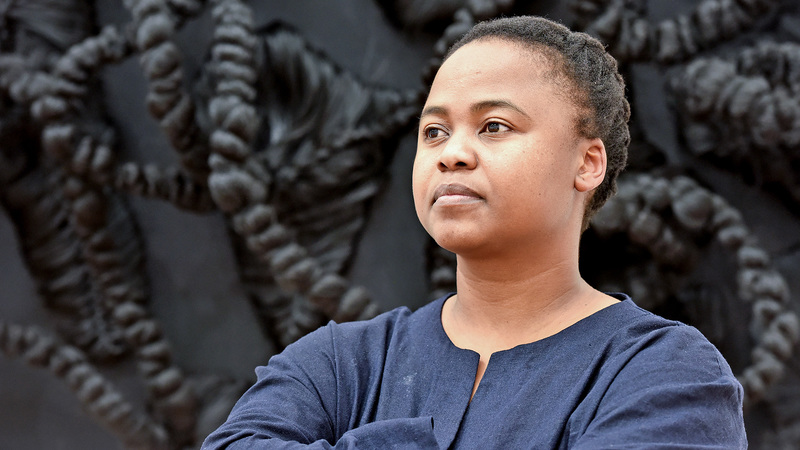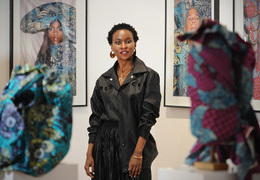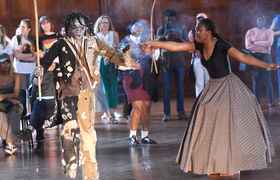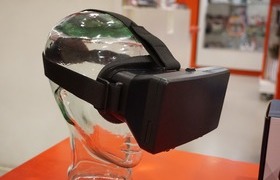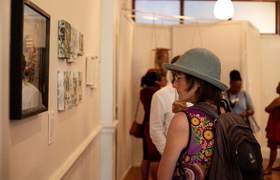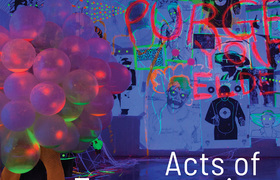Redressing past injustices with art
10 September 2020 | Story Niémah Davids. Photos Lerato Maduna. Video directors Lerato Maduna and Roxanne Harris. Camerawork Evan Zerf. Video Edit Oatmeal Productions. Read time 8 min.Reshaping the University of Cape Town’s (UCT) art collection and transforming it into a resource for researchers, curators and students is what Associate Professor Nomusa Makhubu aims to achieve during her tenure as the chairperson of the Works of Art Collection (WOAC) committee.
The WOAC committee oversees the display and integration of art into campus life and is in the process of unpacking an important question: What does art mean to the wider UCT community? The university boasts a vast visual art collection, which comprises approximately 1 700 artworks across 70 UCT buildings.
The committee also plays a critical role in redressing some of the past’s injustices through its commitment to purchase artwork by both prominent and emerging artists in South Africa. In addition, it re-curates how artwork is displayed across campus to ensure that the work reflects the diverse array of UCT staff and students.
Associate Professor Makhubu’s term kicked off on 1 July 2020. She has taken over from Associate Professor Jay Pather, who headed the committee for three years.
Works of art curated by the WOAC committee hang inside the GSB Academic Conference Centre and inside Michaelis Galleries.
UCT News spoke to her about her new role and her vision for the WOAC.
Niémah Davids (ND): What does your role as chairperson of UCT’s WOAC committee entail?
Nomusa Makhubu (NM): It is centred on working with committee members and liaising with the university administration in order to fulfil our mandate, which is to build a collection of artwork in line with the university’s vision and mission. Promoting the display of our collection through engaged curation and ensuring [that] it is safeguarded and contributes to an inclusive heritage expression for the university is also an important part of the role.
“I look forward to collectively thinking about exciting strategies for curation and facilitating ongoing dialogue about artwork.”
ND: What are some of the things you’re looking forward to achieving as chairperson?
NM: The ideal would be to shape our art collection as a resource for researchers, curators and students. With the committee’s support, I look forward to collectively thinking about exciting strategies for curation and facilitating ongoing dialogue about artwork, its complex meanings and impact on the public.
ND: In recent years there’s been ongoing debate about the need to transform UCT’s art collection. What are some of the changes you’d like to drive during your tenure?
NM: Transformation is a priority. An institutional art collection maintains historical and cultural value only when it is socially responsive and when there is a measure of self-reflexivity in terms of the institutional practices it engenders. We have established a working group, and we are in the process of identifying the key areas that will need to be addressed. We recognise that we need to refine our acquisition strategy, while conserving certain artwork and diversifying the curation and site-specific installations. These discussions are currently under way and will inform the three-year plan which we have embarked on.
“The foundational work in transforming the art collection and enriching the discourse emanating from it has begun in earnest.”
ND: How inclusive is UCT’s current artwork of a new South Africa?
NM: We still have a long way to go to shape our art collection into one that reflects the socio-cultural dynamics in South Africa and beyond our borders. There are significant gaps when it comes to race and gender in our collection, which we have been in the process of filling in these past few years. We also need to develop an in-depth collection reflecting key historical categories by, for example, acquiring artworks of key African modern artists and African contemporary artists based outside of Cape Town.
The foundational work in transforming the art collection and enriching the discourse emanating from it has begun in earnest and will continue in the months to come.
Public art around campus – part of the UCT art collection.
ND: You’ve acknowledged that UCT still has a long way to go to transform its art collection, but can I ask you to talk about what the committee has put in place to help achieve this?
NM: We’ve certainly managed to achieve this through new acquisitions and re-curation. We are thrilled that works by both established and emerging artists have been purchased and are [being] displayed at various sites on campus. This is an incredible achievement.
Under the guidance of Associate Professor Jay Pather, [the] WOAC committee has in the past few years embarked on a number of public engagements, performances and panel discussions to address some of the salient issues we face. These interactions have been crucial to facilitate deeper conversations on racial and gender representation and the different forms of violence.
This is an important part of [the] WOAC committee’s mandate and our response to the broader call for social justice. It requires us to remain [conscious] of the powerful impact art can have on the social imaginary.
ND: Has UCT succeeded in ensuring the collection is easily accessible to both staff and students?
“The question of accessibility has been an important one for the committee.”
NM: The question of accessibility has been an important one for the committee. While there are a few artworks installed in access-controlled areas, the majority of UCT’s art collection is installed across campus in public spaces. This means that it’s easily accessible to the UCT community.
However, there’s been no platform that enables all members of the UCT community to view the work in the collection and learn more about each piece. To help us address this, we have recently created the WOAC website to serve as an archive of past WOAC committee-organised interventions, a platform to showcase upcoming events and an entry point to get to know the collection. This work has been expertly initiated and steered by my predecessor, Associate Professor Pather, and the director of the Irma Stern Museum, Nadja Daehnke.
The question of accessibility also demands that we question the fact that much of the work on campus is not in all cases multisensory; it is in fact ocular-centric. Therefore, we must find strategies for accessibility without reinforcing ableism. In some ways, the online platform may allow for possibilities or alternatives for making the collection accessible to as many people in the UCT community as possible. As a committee, we will also continue to develop new ways of ensuring accessibility.
ND: What are some of the measures in place to ensure that the collection is accessible to the general public?
NM: UCT’s art collection is accessible to the public to the extent that the public can access [the] university relatively easily. But the website is one other way of ensuring the collection is accessible to those outside the campus community. We really want it to be an educational resource that attracts researchers from other institutions and organisations both in and outside South Africa.
ND: Looking ahead, what are you most excited about?
NM: I’d have to say that I am most excited about the possible interventions aimed at public engagements, which we’re currently planning.
 This work is licensed under a Creative Commons Attribution-NoDerivatives 4.0 International License.
This work is licensed under a Creative Commons Attribution-NoDerivatives 4.0 International License.
Please view the republishing articles page for more information.


